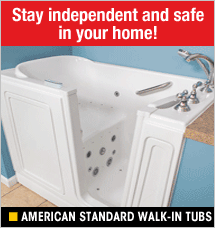Washington Watch
Desperately Seeking Answers to Medicare Spending and Scams

 Last year, one out of every six dollars Medicare spent went to nursing care and therapy for patients in rehabilitation facilities, nursing homes, long-term care and in their own homes, a congressional advisory panel found. Now, after years of trying to slow hospital spending, the Obama administration is hoping to get a handle on and dramatically reduce what Medicare spends on patients after they have left the hospital.
Last year, one out of every six dollars Medicare spent went to nursing care and therapy for patients in rehabilitation facilities, nursing homes, long-term care and in their own homes, a congressional advisory panel found. Now, after years of trying to slow hospital spending, the Obama administration is hoping to get a handle on and dramatically reduce what Medicare spends on patients after they have left the hospital.
Post-acute or post-hospital care has grown at 5 percent a year or faster in 34 of the nation’s most populous hospital markets in recent years, according to a new analysis for Kaiser Health News (KHN). While comparing this kind of care in the different states, they found vast discrepancies in how much is spent on these services in different areas around the country.
Chapin White, a former Congressional Budget Office economist, working for the news service, found that in Connecticut, for example, Medicare beneficiaries are more than twice as likely to end up in a nursing home as they are in Arizona. Medicare spends $8,800 on each Louisiana patient getting home health care – $5,000 more than it spends on the average New Jersey senior citizen. In Chicago, the report found, one out of four Medicare beneficiaries receives additional services after leaving the hospital – three times the rate in Phoenix.
Everyone seems to be making money from Medicare for services provided to seniors after their hospital stay. But some of these providers earned big profits from Medicare through what KHN described as “a hodgepodge of payment methods that health experts say encourages unnecessary and disjointed care, wastes taxpayer money and makes fraud easier.”
Medicare records show that more than 25 percent of Medicare spending in Louisiana, Texas, Mississippi, Oklahoma and Massachusetts was for post-hospital care in 2011. Where the great disconnect happens is when the patient is dismissed from the hospital. Much of the time, hospitals don’t take into account costs to patients or even what’s in the patient’s best interest. It’s strictly about the money.
Not surprisingly, the problem developed over many years because of Medicare’s rules. The growth of the post-hospital industry traces back to actions Medicare took in the 1980s to crack down on long in-patient hospital stays. To limit that practice, Medicare started paying hospitals set amounts of money for each patient stay, giving them a financial reason to discharge patients as soon as they could. New companies and new services developed around the country to take these patients, often with business models designed specifically to get as much money as they could legally earn from Medicare.
Looking for the Fix
But now the Obama administration is planning to change the system to try and save money. Medicare is experimenting with new payment methods in which hospitals and post-acute providers would be given a lump sum amount to take care of a patient. That would force them to become more efficient if they want to make money, Medicare experts suggest. At the same time, Obama has proposed reducing payments for some conditions to post-acute providers and beginning to standardize the rates that are paid for similar patients.
Part of the problem is there are no real standards and definitions of what “post-acute means” so Medicare patients are treated differently depending on their hospital experiences. Those healthy enough to return to their homes quickly can receive occasional visits for home health services from nurses, physical therapists and aides who monitor their condition and assist in basic tasks.
But patients needing closer oversight often end up in nursing homes or in-patient rehabilitation facilities. These tend to be people who have broken hips, suffered strokes or had major joint replacements and fractures. The sickest patients, including those who need ventilators to breathe for weeks, are often sent to long-term care hospitals, where the average stay is 26 days.
Surprisingly, Medicare pays each type of facility different rates, even when they are treating the same kinds of patients. The Obama administration is trying to sort through all of this and standardize care and dollar amounts. Medicare’s cost averages $33,000 for stroke patients discharged instead to a nursing home and only $13,000 for those care for at home with the assistance of health aides, the analysis found. The assumption underlying those payments is that sicker patients need to be in facilities that provide more intense care. But researchers have found evidence that the same type of patients can end up in different types of facilities for no apparent reason.
Hospital administrators and officials at the different facilities say they often reject as many as half of the patients hospitals refer because they do not meet Medicare’s criteria. A July Institute of Medicine study found that post-hospital services are the main reason that Medicare spends much more in some parts of the nation than elsewhere.
Take McAllen, Texas as an example. In that warm climate, located just along the South Texas-Mexico border, doctors and hospitals have the highest Medicare spending – greater than anywhere else except Miami. White found that Medicare records show inpatient hospital use and spending in 2011 was around the national average and outpatient care was significantly below average. Post-acute spending was the thing that stood out.
Medicare beneficiaries in McAllen were more than 2½ times as likely to use home health services, long-term care hospitals and rehab facilities than was the average Medicare beneficiary in 2011. That resulted in Medicare spending $4,752 per capita on post-acute services, while the national per capita spending average was $1,894.
How available post-hospital use is largely determined by which facilities are around the area. A third of all home health care cases took place in 5 states – Texas, Florida, Louisiana, Mississippi and Oklahoma – even though only 17 percent of Medicare beneficiaries live in those states, according to the Medicare Payment Advisory Commission (MedPAC).
One of the other factors in determining where patients get sent is how aggressively marketed the facilities are to patients and to health care companies. Profit is what drives these businesses and most are quite profitable. Nursing homes are expected to earn between 12 and 14 percent this year on their Medicare patients, MedPAC estimates. Home health margins are expected to average 12 percent and intensive rehab facilities are at about 8.5 percent, they estimate. Long-term care hospitals are earning about 6 percent. So it is no surprise, according to policy experts, that these facilities do whatever they can to wring the most money out of Medicare’s payment methods.
According to White’s analysis, nursing homes are paid per day, encouraging homes to keep patients for as long as possible up to the 100-day limit Medicare set. Medicare picks up the entire tab for the first 20 days. MedPAC calculates that even including money-losing Medicaid patients, nursing homes earned profits between 4 to 6 percent in 2011, the most recent year for which there is data.
Home health agencies are paid set fees for 60 days with no regard for how many nursing and aide visits are made. The number of visits in the average 60-day period dropped from 32 in 1998 to 19 in 2011, while the number of patients enrolled in home health soared, with most of them no longer coming straight from the hospital, according to MedPAC. "The incentive is to sign up patients who need hardly anything and sign them up for as long as you can get them," Judy Feder, a professor at the Georgetown Public Policy Institute, told KHN recently.
With profit as the primary motive, it is no surprise that there has been outright fraud by some folks in trying to game the system. Last summer, the Centers for Medicare & Medicaid Services placed a temporary moratorium on new home health agencies in Miami and Chicago after CMS auditors found nursing homes billing for services that were never provided and home health agencies billing for people who were well enough to leave their homes.
Another part of the problem is that there are so many facilities that many hospitals do not have close relationships with them. The healthcare advisory group Avalere’s researcher Tumlinson analyzed where patients from 10 different Chicago hospitals in 2010 went after discharge. She found that on average, the hospitals sent patients to 130 different nursing homes. “How on earth can a hospital ever get a handle on this and have a relationship with the patient post-discharge if they are dealing with this many different skilled nursing facilities” she questions.
In an effort to rein in an unwieldy system, the Center for Medicare & Medicaid Innovation is conducting experiments to change the financial calculus for both hospitals and post-acute providers. The center has received proposals for numerous “bundled payment” experiments in which hospitals and post-acute providers will work together to treat Medicare patients for a fixed sum instead of being paid separately. Another group of experiments, involving only the post-acute providers, is also underway, many by private companies that have recruited medical providers.
One of the more interesting private companies is NaviHealth, created by former Medicare
administrator Tom Scully. His company evaluates hospitalized patients to determine where they should be discharged afterwards and then aggressively follows their care along the way. They are experimenting with Medicare bundling payments in hospitals in Tennessee, Oklahoma, New Mexico and New Jersey.
"We catch patients in their second day in the hospital and come up with a very detailed evaluation of their functional status," Scully told KHN. "Maybe you should be in the rehab hospital for 14 days, or nursing home for 10 days instead of 20 days," which is the most days before Medicare starts charging patients a co-payment. Otherwise, he said, "the nursing home will keep you for the maximum days they can. It's nobody's fault, it's just the incentives." Scully’s company is also managing the post-acute treatments for some patients in private Medicare advantage and Medicare supplemental plans.
Will this work, or will it just cause a new series of problems? Some experts warn that the way the hospital payment system led to an explosion in post-acute care, these new ideas could have unintended consequences. As Georgetown’s Public Policy Institute’s Judy Feder told Kaiser Health News, "The incentive is to avoid the sick and skimp on services," Feder said. Either way, it could have result in big changes to seniors in how Medicare pays for their health care.
[Contributing to this story was Kaiser Health News in collaboration with the Washington Post.]
Alan Schlein runs DeadlineOnline.com, an internet training and consulting firm. He is the author of the bestselling “Find It Online” books.
John Stinger Cartoon





























































